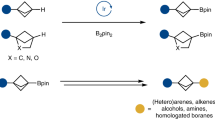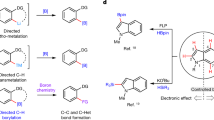Abstract
MIDA boronates (N-methylimidodiacetic boronic acid esters) serve as an increasingly general platform for small-molecule construction based on building blocks, largely because of the dramatic and general rate differences with which they are hydrolysed under various basic conditions. Yet the mechanistic underpinnings of these rate differences have remained unclear, which has hindered efforts to address the current limitations of this chemistry. Here we show that there are two distinct mechanisms for this hydrolysis: one is base mediated and the other neutral. The former can proceed more than three orders of magnitude faster than the latter, and involves a rate-limiting attack by a hydroxide at a MIDA carbonyl carbon. The alternative ‘neutral’ hydrolysis does not require an exogenous acid or base and involves rate-limiting B–N bond cleavage by a small water cluster, (H2O)n. The two mechanisms can operate in parallel, and their relative rates are readily quantified by 18O incorporation. Whether hydrolysis is ‘fast’ or ‘slow’ is dictated by the pH, the water activity and the mass-transfer rates between phases. These findings stand to enable, in a rational way, an even more effective and widespread utilization of MIDA boronates in synthesis.
This is a preview of subscription content, access via your institution
Access options
Subscribe to this journal
Receive 12 print issues and online access
$259.00 per year
only $21.58 per issue
Buy this article
- Purchase on Springer Link
- Instant access to full article PDF
Prices may be subject to local taxes which are calculated during checkout






Similar content being viewed by others
References
Li, J., Grillo, A. S. & Burke, M. D. From synthesis to function via iterative assembly of N-methyliminodiacetic acid boronate building blocks. Acc. Chem. Res. 48, 2297–2307 (2015).
Gillis, E. P. & Burke, M. D. A simple and modular strategy for small molecule synthesis: iterative Suzuki−Miyaura coupling of B-protected haloboronic acid building blocks. J. Am. Chem. Soc. 129, 6716–6717 (2007).
Knapp, D. M., Gillis, E. P. & Burke, M. D. A general solution for unstable boronic acids: slow-release cross-coupling from air-stable MIDA boronates. J. Am. Chem. Soc. 131, 6961–6963 (2009).
Lennox, A. J. J. & Lloyd-Jones, G. C. Organotrifluoroborate hydrolysis: boronic acid release mechanism and an acid–base paradox in cross-coupling. J. Am. Chem. Soc. 134, 7431–7441 (2012).
Woerly, E. M., Roy, J. & Burke, M. D. Synthesis of most polyene natural product motifs using just 12 building blocks and one coupling reaction. Nature Chem. 6, 484–491 (2014).
Li, J. et al. Synthesis of many different types of organic small molecules using one automated process. Science 347, 1221–1226 (2015).
Dick, G. R., Woerly, E. M. & Burke, M. D. A general solution for the 2-pyridyl problem. Angew. Chem. Int. Ed. 51, 2667–2672 (2012).
Fyfe, J. W. B., Seath, C. P. & Watson, A. J. B. Chemoselective boronic ester synthesis by controlled speciation. Angew. Chem. Int. Ed. 53, 12077–12080 (2014).
Li, J. & Burke, M. D. Pinene-derived iminodiacetic acid (PIDA): a powerful ligand for stereoselective synthesis and iterative cross-coupling of C(sp3) boronate building blocks. J. Am. Chem. Soc. 133, 13774–13777 (2011).
Grob, J. E. et al. One-pot C–N/C–C cross-coupling of methyliminodiacetic acid boronyl arenes enabled by protective enolization. Org. Lett. 14, 5578–5581 (2012).
Gillis, E. P. & Burke, M. D. Multistep synthesis of complex boronic acids from simple MIDA boronates. J. Am. Chem. Soc. 130, 14084–14085 (2008).
Bender, M. L. & Thomas, R. J. The concurrent alkaline hydrolysis and isotopic oxygen exchange of a series of p-substituted methyl benzoates. J. Am. Chem. Soc. 83, 4189–4193 (1961).
Blandamer, M. J., Engberts, J. B. F. N., Gleeson, P. T. & Reis, J. C. R. Activity of water in aqueous systems; a frequently neglected property. Chem. Soc. Rev. 34, 440–458 (2005).
Treiner, C., Bocquet, J.-F. & Chemla, M. Seconds coefficients du viriel des melanges eau-tetrahydrofurane (THF) influence sur les coefficients d'actitivite de l'eau et du THF a 25 °C. J. Chim. Phys. Chim. Biol. 70, 72–79 (1973).
Krishtalik, L. I. On the theory of the ‘proton inventory’ method. Mendeleev Commun. 3, 66–67 (1993).
Glew, D. N. & Watts, H. Aqueous non-electrolyte solutions. Part XII. Enthalpies of mixing of water and deuterium oxide with tetrahydrofuran. Can. J. Chem. 51, 1933–1940 (1973).
Schowen, R. L. The use of solvent isotope effects in the pursuit of enzyme mechanisms. J. Label. Compd Radiopharm. 50, 1052–1062 (2007).
Bender, M. L., Matsui, H., Thomas, R. J. & Tobey, S. W. The concurrent alkaline hydrolysis and isotopic oxygen exchange of several alkyl benzoates and lactones. J. Am. Chem. Soc. 83, 4193–4196 (1961).
Frisch, M. J. et al. Gaussian 09 (Gaussian, Inc. Wallingford, Connecticut, 1973).
Zhao, Y. & Truhlar, D. G. The M06 suite of density functionals for main group thermochemistry, thermochemical kinetics, noncovalent interactions, excited states, and transition elements: two new functionals and systematic testing of four M06-class functionals and 12 other functionals. Theor. Chem. Acc. 120, 215–241 (2008).
Hariharan, P. C. & Pople, J. A. The influence of polarization functions on molecular orbital hydrogenation energies. Theor. Chim. Acta 28, 213–222 (1973).
Miertus, S., Scrocco, E. & Tomasi, J. Electrostatic interaction of a solute with a continuum. A direct utilization of ab initio molecular potentials for the prevision of solvent effects. Chem. Phys. 55, 117–129 (1981).
Beno, B. R., Houk, K. & Singleton, D. A. Synchronous or asynchronous? An ‘experimental’ transition state from a direct comparison of experimental and theoretical kinetic isotope effects for a Diels–Alder reaction. J. Am. Chem. Soc. 118, 9984–9985 (1996).
Guthrie, J. P. Hydration of carbonyl compounds, an analysis in terms of multidimensional Marcus theory. J. Am. Chem. Soc. 122, 5529–5538 (2000).
Guthrie, J. P. & Pitchko, V. Hydration of carbonyl compounds, an analysis in terms of no barrier theory: prediction of rates from equilibrium constants and distortion energies. J. Am. Chem. Soc. 122, 5520–5528 (2000).
Gunaydin, H. & Houk, K. N. Molecular dynamics prediction of the mechanism of ester hydrolysis in water. J. Am. Chem. Soc. 130, 15232–15233 (2008).
Geissler, P. L., Dellago, C., Chandler, D., Hutter, J. & Parrinello, M. Autoionization in liquid water. Science 291, 2121–2124 (2001).
Besbes, R., Ouerfelli, N. & Latrous, H. Density, dynamic viscosity, and derived properties of binary mixtures of 1,4 dioxane with water at T = 298.15 K. J. Mol. Liq. 145, 1–4 (2009).
Woolley, E. M., Hurkot, D. G. & Hepler, L. G. Ionization constants for water in aqueous organic mixtures. J. Phys. Chem. 74, 3908–3913 (1970).
Butters, M. et al. Aryl trifluoroborates in Suzuki–Miyaura coupling: the roles of endogenous aryl boronic acid and fluoride. Angew. Chem. Int. Ed. 49, 5156–5160 (2010).
Perrin, C. L. & Dong, Y. Secondary deuterium isotope effects on the acidity of carboxylic acids and phenols. J. Am. Chem. Soc. 129, 4490–4497 (2007).
Pehk, T., Kiirend, E., Lippmaa, E., Ragnarsson, U. & Grehn, L. Determination of isotope effects on acid–base equilibria by 13C NMR spectroscopy. J. Chem. Soc. Perkin Trans. 2 445–450 (1997).
Acknowledgements
G.C.L.-J. is a European Research Council (ERC) Advanced Investigator. The research leading to these results has received funding from the ERC under the European Union's Seventh Framework Programme (FP7/2007-2013)/ERC grant agreement No. 340163, and the US National Institutes of Health. G.C.L.-J. and J.A.G. thank CONACYT and The University of Edinburgh for generous support. M.D.B. acknowledges financial support from the US National Institutes of Health (GM118185). P.H.-Y.C. is the Bert and Emelyn Christensen Professor of Oregon State University and acknowledges financial support from the Stone family and the US National Science Foundation (NSF, CHE-1352663). K.N.H. is the Saul Winstein Chair in Organic Chemistry at the University of California Los Angeles and acknowledges financial support from the US NSF (CHE-1059084). O.M.O. acknowledges Tartar research support. O.M.O. and P.H.-Y.C. also acknowledge computing infrastructure in part provided by the NSF Phase-2 CCI, Center for Sustainable Materials Chemistry (NSF CHE-1102637).
Author information
Authors and Affiliations
Contributions
Experimental work was conducted by J.A.G. and G.F.M. Computational work was conducted by O.M.O., N.R., P.H.-Y.C. and A.G.L. G.C.L.-J., M.D.B., P.H.-Y.C., A.G.L. and K.N.H. wrote the manuscript.
Corresponding authors
Ethics declarations
Competing interests
The University of Illinois has filed patent applications related to MIDA boronate chemistry, and these have been licensed to REVOLUTION Medicines, a company for which M.D.B. is a founder and consultant.
Supplementary information
Supplementary information
Supplementary information (PDF 13129 kb)
Rights and permissions
About this article
Cite this article
Gonzalez, J., Ogba, O., Morehouse, G. et al. MIDA boronates are hydrolysed fast and slow by two different mechanisms. Nature Chem 8, 1067–1075 (2016). https://doi.org/10.1038/nchem.2571
Received:
Accepted:
Published:
Issue Date:
DOI: https://doi.org/10.1038/nchem.2571
This article is cited by
-
PdNPs/NiNWs as a welding tool for the synthesis of polyfluorene derivatives by Suzuki polycondensation under microwave radiation
Scientific Reports (2024)
-
Automated iterative Csp3–C bond formation
Nature (2022)
-
Regio- and stereoselective synthesis of tetra- and triarylethenes by N-methylimidodiacetyl boron-directed palladium-catalysed three-component coupling
Communications Chemistry (2019)
-
Towards the generalized iterative synthesis of small molecules
Nature Reviews Chemistry (2018)
-
Amine hemilability enables boron to mechanistically resemble either hydride or proton
Nature Chemistry (2018)



